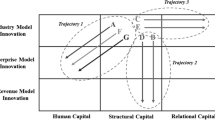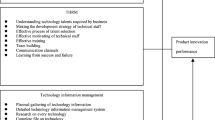Abstract
Based on country-level comparisons, this study applies geographic (internal vs. external) and knowledge (exploitation vs. exploration) boundaries to explore the influence of knowledge sources and ambidexterity on production and innovation performance in the thin film transistor-liquid crystal display (TFT-LCD) industries of the three major players, Japan, Korea, and Taiwan, from 1995 to 2009. Our findings suggest that different resource-based industrial development strategies are associated with the specific knowledge acquisition strategies in the technology leader, Japan and its followers, Korea and Taiwan. The contribution of this study is empirical verification of the influence of knowledge sources and ambidextrous capabilities on production and innovation activities in the TFT-LCD industries of these countries. Since each country is endowed with different resources, this study aims to reveal the strong implications of this for the design of an industrial strategy that has to acquire both known and new knowledge through internal and external sources simultaneously, while carefully integrating them and exploiting their interactions.


Similar content being viewed by others
Notes
The global TFT-LCD industry was moving from an introductory to a growth stage in the early 2000s, where industrial structure shifted towards horizontal integration and mass production capability became a focus. As Romer (1990) argues, technical innovation is explicitly formulated as product innovation whereby new markets are introduced through new products in the industrial introductory stage; the other type being process innovation in which new and improved production methods (usually through specialization and mechanization) are introduced to increase productivity in the industrial growth stage.
The US and the latecomers China and Singapore are not considered here, either because they do not contribute to global TFT-LCD production, or because they have not yet demonstrated their significance (having <5 % of the TFT-LCD global market share up to 2009) (IDC 2009).
It is not until the beginning of 2009, LG Philips became LG Display after Philips withdrew its investment stake’.
At the end of 2009, Innolux subsequently merged with TPO and CMO, retaining the CMO name.
The IPC is an international standard to classify technologies in patent applications; it divides technologies into eight sections with approximately 70,000 subdivisions. Please see the WIPO for the details, www.wipo.int/classifications/ipc/en/general/preface.html.
There are several reasons why it may be claimed that the use of USPTO data is the most reliable means of exploring innovation capability in this case. Firstly, these data include statistics determined by the USPTO during registration that are becoming a global standard. Secondly, US patents have been found to be an adequate indicator of the economic importance of patenting in general (Hall and Ziedonis 2002). Finally, the USPTO data have a unique feature in that they capture the links between an invention and the prior knowledge with which it is most closely associated (Grupp and Schmooh 1999).
We have operated the Pearson correlations for each independent variable in the three countries as seen in Appendix 2.
References
Akamatsu, K. (1961). A theory of unbalanced growth in the world economy. Weltwirtschaftliches Archiv, 86(2), 196–217.
Barnett, W. P., & Freeman, J. (2001). Too much of a good thing? Product proliferation and organizational failure. Organization Science, 12(5), 539–558.
Carolan, M. S. (2009). The problems with patents: A less than optimistic fading of the future. Development and Change, 40(2), 361–388.
Cohen, W. M., & Levinthal, D. A. (1990). Absorptive capacity: A new perspective on learning and innovation. Administrative Science Quarterly, 35(1), 128–152.
Duncan, R. B. (1976). The ambidextrous organization: Designing dual structures for innovation. In R. H. Kilmann, L. R. Pondy, & D. P. Slevin (Eds.), The management of organization design (Vol. I, pp. 167–188)., Strategies and Implementation New York: Elsevier.
Furman, J. L., Porter, M. E., & Stern, S. (2002). The determinants of national innovative capacity. Research Policy, 31(6), 899–933.
Geisler, E. (2008). Knowledge and knowledge systems: Learning from the wonders of the mind. Hershey: IGI Publiser.
Grupp, H., & Schmooh, U. (1999). Patent statistics in the age of globalization: New legal procedures, new analytical methods, new economic interpretation. Research Policy, 28, 377–396.
Hagedoorn, J., & Cloodt, M. (2003). Measuring innovative performance: Is there an advantage in using multiple indicators? Research Policy, 32(8), 1365–1379.
Hall, B. H., & Ziedonis, R. H. (2002). The patent paradox revisited: An empirical study of patenting in the US semiconductor industry 1979–1995. Rand Journal of Economics, 32(1), 101–128.
Hatch, W., & Yamamura, K. (1996). Asia in Japan’s embrace: Building a regional production alliance. Cambridge: Cambridge University Press.
Hoang, H. T., & Rothaermel, F. T. (2005). The effect of general and partner-specific Alliance experience on joint R&D Project performance. The Academy of Management Journal, 48(2), 332–345.
Hu, M. C. (2008). Knowledge flows and innovation capability: The patenting trajectory of Taiwan’s thin film transistor-liquid crystal display industry. Technological Forecasting and Social Change, 75(9), 1423–1438.
Hu, M. C. (2012). Technological innovation capabilities in the thin film transistor-liquid crystal display industries of Japan, Korea, and Taiwan. Research Policy, 41(3), 541–555.
Hu, A. G. Z., & Jaffe, A. B. (2003). Patent citations and international knowledge flow: The cases of Korea and Taiwan. International Journal of Industrial Organization, 21(6), 849–880.
Hu, M. C., & Mathews, J. A. (2005). National innovative capacity in East Asia. Research Policy, 34(9), 1322–1349.
IDC (International Data Corporation). (2009). Dynamic Development of Worldwide LCD Panel Industry. Presented by Anneable Hsu on 14 May 2009.
Jaffe, A. B., & Trajtenberg, M. (1999). International knowledge flows: Evidence from patent citations. Economics of Innovation and New Technology, 8(1–2), 105–136.
Jang, S. L., Lo, S., & Chang, W. (2009). How do latecomers catch up with forerunners? Analysis of patents and patent citations in the field of flat panel display technologies. Scientometrics, 79(3), 563–591.
Jensen, M. B., Johnson, B., Lorenz, E., & Lundvall, B. Å. (2007). Forms of knowledge and modes of innovation. Research Policy, 36(5), 680–693.
Johnstone, B. (1999). We were burning: Japanese entrepreneurs and the forging of the electronic age. Boulder, CO: Basic Books.
Kim, L. (1998). Crisis construction and organizational learning: Capability building in catching-up at Hyundai motor. Organization Science, 9(4), 506–521.
Kodama, F. (1991). Analyzing Japanese high technologies: The techno-paradigm Shift. New York: Pinter Publishers.
Kojima, K. (2000). The “Flying Geese” Model of Asian Economic Development: Origin, theoretical extensions, and regional policy implications. Journal of Asian Economics, 11(4), 375–401.
Lavie, D., & Rosenkopf, L. (2006). Balancing exploration and exploitation in alliance formation. The Academy of Management Journal, 49(4), 797–818.
Levinthal, D. A., & March, J. G. (1993). The myopia of learning. Strategic Management Journal, 14(S2), 95–112.
Linden, G., Hart, J., Lenway, S. J., & Murtha, T. P. (1998). Flying geese as moving targets: Are Korea and Taiwan catching up with Japan in advanced displays? Industry and Innovation, 5(1), 11–34.
Lubatkin, M., Simsek, H. Z., Ling, Y., & Veiga, J. F. (2006). Ambidexterity and performance in small-to medium-sized firms: The pivotal role of top management team behavioral integration. Journal of Management, 32(5), 646–672.
Mahmood, I. P., & Singh, J. (2003). Technological dynamism in Asia. Research Policy, 32(6), 1031–1054.
March, J. G. (1991). Exploration and exploitation in organizational learning. Organization Science, 2(1), 71–87.
Mathews, J. A. (2005). Strategy and the crystal cycle. California Management Review, 47(2), 6–32.
O’Hara, P. (2008). Principle of circular and cumulative causation: Fusing Myrdalian and Kaldorian growth and development dynamics. Journal of Economic Issue, 42(2), 375–387.
O’Reilly, C. A, I. I. I., & Tushman, M. L. (2004). The ambidextrous organization. Harvard Business Review, 82(4), 74–81.
O’Reilly, C. A, I. I. I., & Tushman, M. L. (2007). Ambidexterity as a dynamic capability: Resolving the innovator’s dilemma. Stanford, CA: Graduate School of Business, Stanford University.
O’Reilly, C. A, I. I. I., & Tushman, M. L. (2011). Organizational ambidexterity in action: How managers explore and exploit. California Management Review, 53(4), 5–22.
Palich, L. E., Cardinal, L. B., & Miller, C. C. (2000). Curvilinearity in the diversification–performance linkage: An examination of over three decades of research. Strategic Management Journal, 21(2), 155–174.
Pavitt, K. (1984). Sectoral patterns of technical change: Towards a taxonomy and a theory. Research Policy, 13(6), 343–373.
Polgar, L. G. (2003). Flat panel displays. Business Economics, 38(4), 62–68.
Romer, P. M. (1990). Endogenous technological change. Journal of Political Economy, 98, S71–S102.
Rothaermel, F. T., & Alexandre, M. T. (2009). Ambidexterity in technology sourcing: The Moderating role of absorptive capacity. Organization Science, 20(4), 759–780.
Saxenian, A., & Hsu, J. Y. (2001). The Silicon Valley–Hsinchu connection: Technical communities and industrial upgrading. Industrial and Corporate Change, 10(4), 893–920.
Shane, S. (2001). Technology regimes and new firm formation. Management Science, 47(9), 1173–1190.
Soo, C., Devinney, T., Midgley, D., & Deering, A. (2002). Knowledge management: Philosophy, process, and pitfalls. California Management Review, 44(4), 129–150.
Sorensona, O., Rivkin, J. W., & Fleming, L. (2006). Complexity, networks and knowledge flow. Research Policy, 35(7), 994–1017.
Stolpe, M. (2002). Determinants of knowledge diffusion as evidenced in patent data: The case of liquid crystal display technology. Research Policy, 31(7), 1181–1198.
Tijssen, R. J. W. (2001). Global and domestic utilization of industrial relevant science: Patent citation analysis of science–technology interactions and knowledge flows. Research Policy, 30(1), 35–54.
Tushman, M. L., & O’Reilly, C. A, I. I. I. (1996). Ambidextrous organizations: Managing evolutionary and revolutionary change. California Management Review, 38(4), 8–30.
World Bank. (2007). How Universities Promote Economic Growth. In S. Yusuf, & K. Nabeshima (Eds.), Washington, DC: World Bank.
Wu, C. Y., & Mathews, J. A. (2012). Knowledge flows in the solar photovoltaic industry: Insights from patenting by Taiwan, Korea, and China. Research Policy, 41, 524–540.
Zahra, S. A., & George, G. (2002). Absorptive capacity: A review, reconceptualization, and extension. The Academy of Management Review, 27(2), 185–203.
Author information
Authors and Affiliations
Corresponding author
Rights and permissions
About this article
Cite this article
Hu, MC., Wu, CY., Lee, J.H. et al. The influence of knowledge source and ambidexterity in the thin film transistor and liquid crystal display industry: evidence from Japan, Korea, and Taiwan. Scientometrics 99, 233–260 (2014). https://doi.org/10.1007/s11192-013-1226-y
Received:
Published:
Issue Date:
DOI: https://doi.org/10.1007/s11192-013-1226-y




